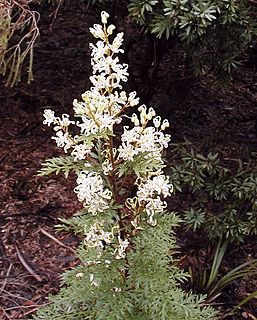
Sembawang is a planning area and residential town located the North Region of Singapore. Sembawang planning area is bordered by Simpang to the east, Mandai to the south, Yishun to the southeast, Woodlands to the west and the Straits of Johor to the north.

Henry Nicholas Ridley CMG (1911), MA (Oxon), FRS, FLS, F.R.H.S. was an English botanist, geologist and naturalist who lived much of his life in Singapore. He was instrumental in promoting rubber trees in the Malay Peninsula and, for the fervour with which he pursued it, came to be known as "Mad Ridley".

Lomatia tasmanica, commonly known as King's lomatia, is a shrub of the family Proteaceae native to Tasmania. Growing up to 8 metres (26 ft) tall, the plant has shiny green pinnate (lobed) leaves and bears red flowers in the summer, but yields neither fruit nor seeds. King's lomatia is unusual because all of the remaining plants are genetically identical clones. Because it has three sets of chromosomes and is therefore sterile, reproduction occurs only vegetatively: when a branch falls, that branch grows new roots, establishing a new plant that is genetically identical to its parent.

Mesua ferrea, the Ceylon ironwood, or cobra saffron, is a species in the family Calophyllaceae. This slow-growing tree is named after the heaviness and hardness of its timber. It is widely cultivated as an ornamental due to its graceful shape, grayish-green foliage with a beautiful pink to red flush of drooping young leaves, and large, fragrant white flowers. It is native to wet, tropical parts of Sri Lanka, India, southern Nepal, Burma, Thailand, Indochina, the Philippines, Malaysia and Sumatra, where it grows in evergreen forests, especially in river valleys. In the eastern Himalayas and Western Ghats in India it grows up to altitudes of 1,500 m (4,900 ft), while in Sri Lanka up to 1,000 m (3,300 ft). It is national tree of Sri Lanka, state tree of Mizoram and state flower of Tripura.

Lomatia is a genus of 12 species of evergreen flowering plants in the protea family Proteaceae. Within the family, they have been placed, alone, in their own subtribe, Lomatiinae according to Johnson & Briggs 1975 classification of the family and subsequently in Flora of Australia (1995).

Nepenthes benstonei is a tropical pitcher plant endemic to Peninsular Malaysia, where it grows at elevations of 150–1350 m above sea level. The specific epithet benstonei honours botanist Benjamin Clemens Stone, who was one of the first to collect the species.
Sembawang Park is a 15-hectare park situated in Sembawang, in the north of Singapore. It is located at the end of Sembawang Road, where the former Sembawang Road End Bus Terminal was.

Acer mandshuricum, is a species of maple native to China, Korea and Russia.

Acer triflorum, the three-flowered maple, is a species of maple native to hills of northeastern China and Korea.

Acer laevigatum, is an atypical species of maple native to southern China, northern India, northern Myanmar, Nepal, and northern Vietnam. It grows at moderate altitudes of 1,000-2,000 m, with a wet monsoon climate.
Anisophyllea ferruginea is a tree of Borneo in the family Anisophylleaceae. The specific epithet ferruginea is from the Latin meaning "rust-coloured", referring to the leaf hairs.

Pseudolmedia is a flowering plant genus in the mulberry family (Moraceae). Species are found in southern Mexico, the Caribbean, and Meso- and South America. They are known in Latin America as lechechiva and used for timber, construction wood, and sometimes in folk medicine.
Cardwellia is a genus of a sole described species of large trees in the plant family Proteaceae. The species Cardwellia sublimis is endemic to the rainforests of the wet tropics region of northeastern Queensland, Australia. Other common names include bull oak, golden spanglewood, lacewood, oak and oongaary. The compound leaves have up to 17 leaflets. It produces white inflorescences followed by woody fruits which are prominently displayed outside the canopy.

Lomatia ferruginea, commonly known as fuinque, is a small evergreen tree in the family Proteaceae.

Darlingia ferruginea, commonly known as the brown silky oak, is a rainforest tree of the family Proteaceae from Northern Queensland.

Nagkesar oil is extracted from seeds of the nagkesar tree. It belongs to the Calophyllaceae family. It is an East Indian evergreen tree and is often planted as an ornamental for its fragrant white flowers that yield a perfume. It is the source of hardwood used for railroad ties. It is Sri Lanka's national tree.
Helicia ferruginea, commonly named hairy honeysuckle or rusty oak, is a species of rainforest trees, of eastern Australia, from the flowering plant family Proteaceae.
Mesua thwaitesii, is a plant species in the family Calophyllaceae. It is endemic to Sri Lanka, where Sinhalese people called "Diya Nā - දිය නා". The plant is highly valuable as a medicinal plant within the country.

Hakea ferruginea, commonly known as rusty hakea, is shrub in the family Proteacea. It has flat leaves and white to cream-coloured flowers from late winter to mid-summer and is endemic to Western Australia.
Dalbergia junghuhnii is a species of shrub placed in the subfamily Faboideae and tribe Dalbergieae; no subspecies are listed in the Catalogue of Life.













